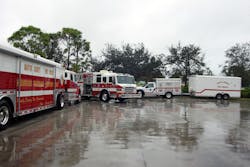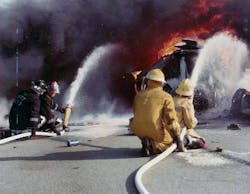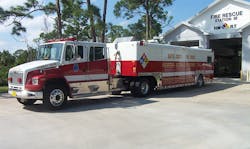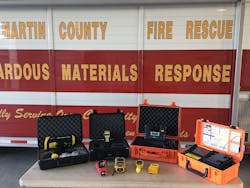Hazmat Studies: The First Volunteer Hazmat Team in the U.S.
Martin County is located along Florida’s Treasure Coast, north of Palm Springs. It is the fifth largest county in Florida, covering an area of 753 square miles, including 543 square miles of land comprised of a mix of suburban, agricultural/rural lands and waterfront. The population of Martin County in 2015 was approximately 156,000, but that number jumps to 200,000 in the winter season, when tourists descend on the area. Martin County Fire-Rescue Department covers all of Martin County, except for the town of Stuart, the county seat.
Building the department
The county career fire department began in 1976 with the hiring of the first career firefighter assigned to Station 21 in Palm City. Additionally, there were four volunteer BLS ambulances and one career ambulance operated by the City of Stuart Police Department.
Chief Steven Wolfberg was hired in 1981 to organize and place in service a career community-wide ALS ambulance service. One year later, the ALS service was operational. During this transition, the county took over ambulance response in the City of Stuart. One of the volunteer ambulances closed, and many members began a new career with the county EMS service.
Around 1981/1982, a career fire marshal named F.T. Seawell was added to the department. Within the next two years, the job transitioned into chief of operations/fire marshal for the entire county. His responsibilities included oversight of all volunteer fire departments in Martin County.
In 1994, Martin County Fire-Rescue and Martin County EMS merged and became today’s Martin County Fire-Rescue.
Today’s Martin County Fire-Rescue
Martin County Fire-Rescue consists of three divisions:
1. Operations, which oversees the Rescue Bureau and includes the Air Medical Transport Unit and Ocean Rescue lifeguards;
2. Division of Emergency Management, which oversees Radiological, Emergency Planning and Special Needs and 9-1-1 Communications; and
3. Administration Division, which oversees the Fire Prevention Bureau, the Training and Safety Bureau as well as the Fleet Services Section and maintenance of all Fire-Rescue facilities.
Martin County Fire-Rescue operates out of 11 stations strategically located throughout the county. Apparatus include eight engines, three trucks, 14 medic units, one air cascade unit, three hazmat units, one decontamination unit, one medical helicopter and seven wildland brush units. Special teams include a dive team as well as a technical rescue team that combines rope rescue, confined space rescue, trench rescue and structural collapse.
In 2016, Martin County Fire-Rescue responded to 4,283 fire-related calls and 18,013 medical emergencies, with 13,247 patients transported to area hospitals. Of the special teams, the LifeStar Evac helicopter was used 210 times, the hazmat team responded to 118 chemical or biological responses, and the technical rescue team responded to 103 incidents.
Additionally, Martin County Ocean Rescue provides protection and response to emergencies at Martin County's four guarded beaches: Bathtub Beach, Hobe Sound Beach, Jensen Beach and Stuart Beach. Beaches are staffed 365 days a year with EMT/ocean lifeguards.
Exposures
Transportation hazmat exposures include two railroads—CSX and FEC—the Atlantic Ocean Intracoastal Waterway and Lake Okeechobee, and two natural gas pipelines. The major highways in Martin County are Interstate 95, State Route 710, Highway 1 and the Florida Turnpike.
Martin County also has fixed hazmat facilities, all within the export-processing zone (EPZ) for Hutchison Island Nuclear Power Plant. Spent fuel rods are stored on site. At times they are moved off site by train and the power plant notifies the fire department.
Other exposures include an ice plant that utilizes anhydrous ammonia; propane gas stations; commercial fishing industry; and explosives for building demos. Chlorine is utilized in water treatment by the county.
Hazmat team history
Chief Edward B. Smith became chief of the department in 1976. Trade magazines were routinely publishing stories of hazmat incidents occurring across the United States. Outside his office window, he could see the trains traveling through Martin County with tank cars carrying hazardous materials. Hazmat response was a new and growing addition to the fire service. Smith, recognizing the potential in his community for chemical incidents, began preparing himself and his firefighters for hazmat emergencies through taking classes and learning as much as they could.
Also in 1976, young Captain Ron Gore of the Jacksonville, FL, Fire Department was tasked with starting the first emergency services hazmat team in the United States. Gore became the “godfather” of hazardous materials response. He also created his own company, Safety Systems, Inc., to train emergency responders not only in Florida, but across the country. His company was one of the first, if not the first, to provide hazmat training for emergency response personnel.
Smith attended a Safety Systems Class and became friends with Gore, and ultimately a partnership developed between Safety Systems and the District-2 Fire Department. District-2 would routinely host Safety Systems classes and, in turn, District-2 members could also attend the classes.
On Dec. 6, 1978, the District-2 Fire Department placed its hazardous materials team in service—the first all-volunteer hazmat team in the country. Its response vehicle was donated by Chief John Caserta of the Grumman Fire Department, who was also a volunteer firefighter with District-2 and formerly the City of Stuart.
Hazmat ops and equipment and PPE
Each hazmat station has a minimum staffing of four members, none of whom are dedicated to the hazmat unit; they also run suppression and rescue as needed. Hazmat response consists of the Duty Station, Hazmat Unit and Squad, which has an air cascade unit on board.
There are 30 technicians on the team. All have received the State of Florida technician certification. Members go through 160 hours of training and must pass a final test. Forty hours of continuing education is required each year in addition to in-service training and off-duty training. Personnel are sent to National Fire Academy training, and the local emergency planning committees also fund additional training.
Hazmat 16 handles all odor, gas leaks and carbon monoxide (CO) calls. Monitoring instruments are not located on any other companies’ apparatus.
Hazmat 16 is a 2002 Freightliner tractor pulling a 30-foot Hackney trailer with rollup doors and a command center. The unit has an onboard generator, light tower, 200 gallons of Class B foam in an on-board tank. The command center includes computers, a printer and fax, and hard copy reference materials for product identification. Other equipment includes decontamination material; PPE; respiratory protection; chlorine kits A, B and C; patching and plugging materials; LP flare-off; dome clamps; grounding and bonding materials; and miscellaneous tools.
Martin County Fire-Rescue also has a mass-decontamination trailer with two tents, a water heater, a generator and built-in showers. Also carried: IDecon kits, additional powered air-purifying respirators (PAPRs), WMD filters, HEPA vacuums and Tyvek suits.
Law enforcement and EMS do not carry hazmat or WMD PPE. In the event the fire department needs additional assistance, they can call Palm Beach and St. Lucie County for assistance. A and B foam is available from the airport and Palm Beach.
Hazmat teams respond to around 100 hazmat calls each year. This does not include engine runs for hydrocarbon fuel spills. Engine companies carry 5 pounds of Sphag Sorb for cleaning up small fuel spills without calling a hazmat company.
Hazmat PPE includes Trellchem HPS and VPS for Level A, Tychem for Level B, and Dupont Tyvec for Level C. Respiratory protection is provided with Scott Safety 60-minute bottles as well as Scott Safety and 3M PAPRs and cartridge respirators. In-suit communications is provided by Scott Voice communications.
Martin County Fire-Rescue Hazmat uses several computer programs, including CAMEO, Marplot/Aloha and Wiser, to assist in hazmat operations. Hard-copy reference books include: ACGIH Guide of Occupational Exposures; Chem-Bio Handbook; CHRIS (Coast Guard Manual); Emergency Care for Hazardous Materials Exposure; Emergency Response Guide Book; Fire Protection Guide to Hazardous Materials; Guidelines for Selection of Chemical Protective Clothing; Hawley's Condensed Chemical Dictionary; Hazardous Materials Desk Reference; Hazardous Materials Response Handbook; Medical Management of Biological Casualties; Merck Index; and the NIOSH Pocket Guide.
For more
For additional information about Martin County Fire-Rescue Hazmat, contact Captain Richard Sterl, hazmat coordinator, at (772) 334-2222 or [email protected].
Sidebar: Monitoring & Detection Equipment
· Ludlum Personnel Radiation Monitor: Displays in mR/hr, uSv/h, dpm, Bq, cpm or cps. Dead-Time Correct (DTC) allows gamma measurements up to 500 mR/hr or up to 1999 uSv/h. It features count rate, dose/exposure and counting alarms as well as a bright red flashing alarm LED.
· MultiRAE Lite: Monitors for lower explosive limit (LEL), CO, H2S, volatile organic compounds (VOC) and chlorine. The wireless connection sends threat and alarm data in real time to a central command, providing awareness for fast incident response.
· MSA Sirius Multi-gas detector: Monitors for LEL, CO, H2S, VOC, chlorine and methane.
· Smiths Detection APD 2000: Handheld monitor and detector designed for emergency first response to hazardous chemical releases and chemical warfare agents (CWA). It simultaneously detects nerve and blister agents and recognizes pepper spray and mace.
· Smiths Detection GasID System: Identifies unknown gases and vapors in minutes. Each chemical has a unique infrared fingerprint. It measures how gases and vapors interact with infrared light and can quickly tell if a gas or chemical is present or not. Analysis takes 10 minutes and compares the results against database libraries that include nerve and blister agents.
· ThermoFisher Scientific FirstDefender and TruDefender chemical detectors.
· M-8 and M-9 chemical detection paper and M256A chemical detection kits.
· MSA HAZMATCAD chemical detector.
· RAMP testers for ricin, anthrax, small pox botulinum.
· Corrosive detection is provided with pH paper and sulfur sticks.
· Qualitative Detector Tubes are provided by Draeger Tubes.
About the Author
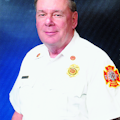
Robert Burke
Robert Burke, who is a hazardous materials and fire protection consultant and who served as a Firehouse contributing editor, is a Certified Fire Protection Specialist (CFSP), Fire Inspector II, Fire Inspector III, Fire Investigator and Hazardous Materials Specialist. He has served on state and county hazmat teams. Burke is the author of the textbooks "Hazardous Materials Chemistry for Emergency Responders," "Counter-Terrorism for Emergency Responders," "Fire Protection: Systems and Response," "Hazmat Teams Across America" and "Hazmatology: The Science of Hazardous Materials."
